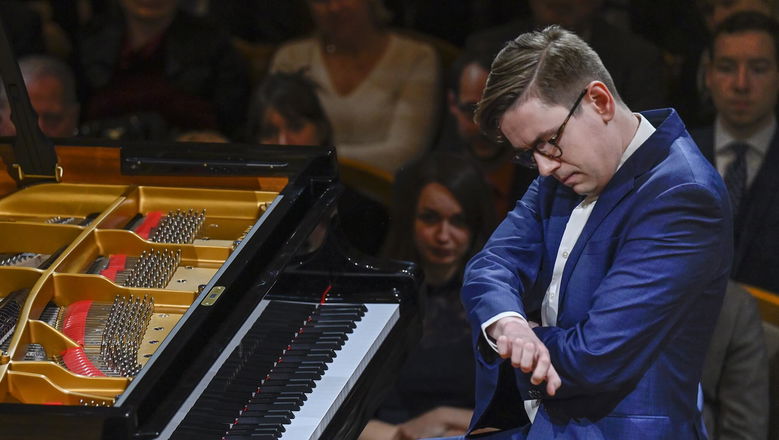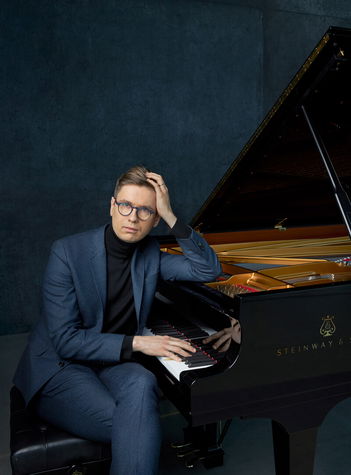1 / 6
Czech Chamber Music Society • Víkingur Ólafsson
Vikingur Ólafsson enjoyed the enthusiastic acclaim of listeners at his recent Czech Philharmonic debut. Now the Icelandic pianist has been invited for another concert, this time in a very intimate collaboration. At the last concert of our new recital series, he will play Johann Sebastian Bach’s Goldberg Variations.
Programme
Johann Sebastian Bach
Goldberg Variations, BWV 988 (74')
Performers
Víkingur Ólafsson piano

Customer Service of Czech Philharmonic
Tel.: +420 227 059 227
E-mail: info@czechphilharmonic.cz
Customer service is available on weekdays from 9 a.m. to 6 p.m.
Aftertalk
After the concert we invite you to an aftertalk with Víkingur Ólafsson in the Dvořák Hall. The aftertalk will be held in English.
Host: Ivo Kahánek
Performers
Víkingur Ólafsson piano

The gifts of the Icelandic pianist Víkingur Ólafsson include perfect pitch and the phenomenon of musical synaesthesia (he “hears” colours). In recent years, he has earned recognition as the world’s “new superstar of classical piano”, as the Daily Telegraph has called him. Critics acclaim his exceptional technical skill and boundless virtuosity, but above all they emphasise his innovative approach to musical interpretation, thanks to which his has been nicknamed “Iceland’s Glenn Gould” (as he was first called by the New York Times). Like Gould, Ólafsson is able to see even very familiar works with new eyes, find their hidden qualities, and arrive at conceptions that are entirely new and yet natural and sensitive.
He demonstrated this most recently with a new CD of Bach’s Goldberg Variations, issued by Deutsche Grammophon in October 2023. “I have dreamed of recording this work for 25 years” says Ólafsson, who devoted an entire concert season to this already successful album, presenting his original interpretation of that masterpiece live on a world tour appearing on six continents to perform at such halls as Carnegie Hall, Vienna’s Konzerthaus, the Zurich Tonhalle, the Philharmonie de Paris, Tokyo’s Suntory Hall, and Prague’s Rudolfinum.
Already in the past, his mastery earned him many awards, such as the title Artist of the Year 2019 awarded by the magazine Gramophone, and his recordings twice earned him the Opus Klassik prize and Album of the Year 2019 from the BBC Music Magazine. Among his most popular albums with the critics and the public, which he recorded on the Deutsche Grammophon label, have been Philip Glass Piano Works (2017), Johann Sebastian Bach (2018), Debussy – Rameau (2020), and Mozart & Contemporaries (2021).
Born in Reykjavik, he got his start at the piano under his mother’s guidance. “As a child, I saw the piano as a toy,” admits Ólafsson, adding that he has been able to preserve that playful approach to some extent not only as a student at the Juilliard School, but even to this day.
Compositions
Johann Sebastian Bach
Goldberg Variations, BWV 988
In 1741, the Nuremberg printer and music publisher Baltharsar Schmid announced a newly prepared edition: “An aria with diverse variations for harpsichord with two manuals, composed for the pleasure of connoisseurs.” The work by the famed Leipzig cantor Johann Sebastian Bach did not get the title “Goldberg Variations” until over half a century later. The edition was the fourth volume of Bach’s Clavierübung (Keyboard Exercises) to be published. The previous three had appeared beginning in 1731 and contained successively partitas, a French overture, an Italian concerto, chorale preludes, and duets. In Bach’s day, the German word “Clavier” referred to all keyboard instruments other than organ, so with each collection the composer always specified the instrument for which the music was preferably intended – the first for single-manual harpsichord or clavichord, the second for two-manual harpsichord, the third for organ, and the fourth, these variations, again for two-manual harpsichord. Because not every variation required two manuals, Bach further specified which parts were to be played on one or two manuals (the titles of individual variations are marked either “a 1 ô vero 2 Clav.” or “a 2 Clav.”). Today, of course, performances of the Goldberg Variations on a modern piano are possible and very frequent. Outstanding pianists managed to use just a single keyboard, brilliantly overcoming the technical difficulties caused by the writing for two keyboards that would allow the two hands to play on top of each other comfortably.
Together, the four volumes of the Clavierübung offered players examples of all of the forms of keyboard compositions of the period: suites, concertos, preludes, fugues, and finally variations. The difficulty of the music definitely is not at a novice level. Bach’s use of the word Übung did not mean an elementary, didactic composition, but rather a means by which advanced players can test and exercise or polish many technical aspects of their artistry. Speaking of an “advanced player”, we should now take a moment to discuss the story that is supposedly behind the creation of these variations. In 1802, Johann Nikolaus Forkel published the first comprehensive biography of Bach, and in it he told the dubious tale of a Russian ambassador to Saxony, Count Hermann Karl von Keyserling, who was making frequent trips to Leipzig, where Bach was then employed, to visit his son studying at the local university. One of the count’s servants was a talented harpsichord player named Johann Gottlieb Goldberg, at the time a pupil of Bach’s eldest son Wilhelm Friedemann in Dresden. The count suffered from insomnia because of his poor health, and he would have Goldberg play the harpsichord at night in the antechamber to his bedroom. In Leipzig, he supposedly asked Bach to compose something for Goldberg to pass the time, making Keyserling’s involuntary nocturnal vigil seem shorter. The purpose of the music being commissioned was not so much to put the listener to sleep as to bring pleasure and diversion. For that purpose, Bach composed an Aria (the theme) and 30 variations. The count is said to have been pleased and to have rewarded Bach lavishly.
So much for the unverified story. It might contain just two true facts: Forkel was the first to call the work the Goldberg Variations, and the name stuck. It is also documented that after 1741 Goldberg became a pupil of Johann Sebastian Bach himself, which might indicate that Goldberg had convinced the composer of his ability – some of the variations are not at all easy to play. Of course, that raises further doubts: in 1741, Goldberg seems to have been just 14 years old. Was he really such a wonderful harpsichordist at that age? It is not even clear how the story came to Forkel. No one involved including Wilhelm Friedemann was still alive by then.
On the one hand, the Goldberg Variations are uplifting or, one might say, a diversion. The work employs dance rhythms and many other “uplifting”, even breathtaking resources, but on the other hand, those resources would be far less effective without the underpinning of rules created on the basis of absolutely rational thinking typical of the arts in Bach’s day. Those rules are based on analogies with the world and nature involving regularity of arrangement, metrical parameters, and numerical relationships.
The thirty variations are regularly divided into ten groups of three. The third variation of each group is always composed as a canon, and in each successive canon, the canonic reply is raised by a step, proceeding from the interval of the unison to the ninth (the third movement thus has the indication “all’Unisono”, the sixth “alla Seconda” etc.). The last set of three ends with the famous Quodlibet as the thirtieth variation, in which Bach contrapuntally combines two folksong melodies. One variation from each set of three is very virtuosic – those are the variations for which a second manual is most often required because the parts are so interwoven that the hands would often collide with each other if playing on a single keyboard (as is the case on the piano). Besides a canon and a virtuosic piece, each set of three variations contains a characteristic movement in the style, for example, of a French dance, a complicated fugue, a freely polyphonic movement, a trio sonata etc. There is also musical logic in the work’s symmetrical division into two halves with 15 variations each and with the Aria at the beginning and at the end – this is why variation no. 16 is in the character of a French overture. Whatever the pattern may be in terms of which we perceive the whole work’s structure, we cannot fail to notice how thoughtfully crafted each variation is by itself, with Bach having given every single one a characteristic, unique contour. Giving each variation a special interpretation based accurately upon its character, voice leading, or tempo turns the whole work into a colourful mosaic.
The Aria, i.e. the theme of the variations, has a genesis of its own. There is already a draft of the theme in the 1725 Notebook for Anna Magdalena Bach, the singer who was the composer’s second wife. Bach shaped the Aria as 32 bars divided into two repeated halves. The Aria is in the character of a three-voice sarabande with a songlike upper voice (for this reason, the word “aria”, typically indicating vocal music, was already being used in instrumental music long before Bach’s day to designate a melodically strong theme preceding variations). Its G major tonality determines the key of all of the variations (with three exceptions in G minor, which are strikingly more dissonant, in the style of a lament– variations 15, 21, and 25). However, the most important point is that in the variations that follow, it is not the melody of the Aria (which has a highly differentiated structure of its own) that Bach elaborates, but rather the bass line. Its first eight descending tones form a “basso ostinato”, familiar since the early Baroque as the basis for variations that allow free handling of the upper voices. Naturally, a composer of Bach’s stature would not repeat the same bassline in all 30 variations. Often, there are only sparse hints of the ostinato, which is broken up rhythmically or structured into all of the voices, but its outline can still be followed. Bach quotes it exactly in the otherwise very complicated thirtieth variation. The following da capo is another a typical late-baroque feature: the Aria returns in the same form as at the beginning. After all of the sophisticated variations and technical fireworks, this reprise has a very calming, soothing effect, as if the music is returning to its roots, bringing the whole magnificent work to a dignified conclusion.